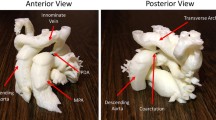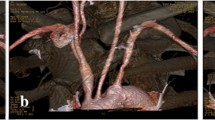Abstract
Purpose
This article aims to discuss the use of three-dimensional (3D) printed models of vascular variation cases as an educational tool for undergraduate and postgraduate anatomy students.
Methods
This advanced study involved ten anatomy assistants who were provided with five distinct cases of congenital cardiovascular variations, each accompanied by a computed tomography angiography (CT-A) and 1:1 solid model format. The residents were asked to generate perceptions for both formats and then compare these perceptions based on identifying the variation, defining the structural features, and evaluating relevant educational perspectives.
Results
The vascular origin measurement values compared to the statistically evaluated real values of the related cases showed that models were 1:1 identical copies. Qualitative assessment feedback from five stations supported the usefulness of 3D models as educational tools for organ anatomy, simulation of variational structures, and overall medical education and anatomy training. Models showcasing different anatomical variations such as aortic arch with Type 2 pattern, a right-sided aortic arch with Type 2 pattern, an aberrant right subclavian artery, arteria lusoria in thorax, and a left coronary artery originating from pulmonary trunk in an Alcapa type pattern allow for better analysis due to their complex anatomies, thus optimizing the study of variation-specific anatomy. The perception level in the 3D model contained higher points in all of the nine parameters, namely identification of cardiovascular variations, defining the vessel with anomaly, aortic arch branch count and appearance order, feasibility of using it in peers and student education. 3D models received a score 9.1 points, while CT-A images were rated at 4.8 out of 10.
Conclusion
3D printed anatomical models of variational cardiovascular anatomy serve as essential components of anatomy training and postgraduate clinical perception by granting demonstrative feedback and a superior comprehension of the visuospatial relationship between the anatomical structures.







Similar content being viewed by others
References
Bati AH, Ozer MA, Govsa F, Pinar Y (2013) Anxiety of first cadaver demonstration in medical, dentistry and pharmacy faculty students. Surg Radiol Anat 35:419–426. https://doi.org/10.1007/s00276-013-1075-7
Choi-Lundberg DL, Low TF, Patman P, Turner P, Sinha SN (2015) Medical student preferences for self-directed study resources in gross anatomy. Anat Sci Educ 9:150–160. https://doi.org/10.1002/ase.1549
Costello JP, Olivieri LJ, Krieger A, Thabit O, Marshall MB, Yoo SJ, Kim PC, Jonas RA, Nath DS (2014) Utilizing three-dimensional printing technology to assess the feasibility of high-fidelity synthetic ventricular septal defect models for simulation in medical education. World J Pediatr Congenit Heart Surg 5:421–426. https://doi.org/10.1177/2150135114528721
Costello JP, Olivieri LJ, Su L, Krieger A, Alfares F, Thabit O, Marshall MB, Yoo SJ, Kim PC, Jonas RA, Nath DS (2015) Incorporating three-dimensional printing into a simulation-based congenital heart disease and critical care training curriculum for resident physicians. Congenit Heart Dis 10:185–190. https://doi.org/10.1111/chd.12238
Cui D, Lynch JC, Smith AD, Wilson TD, Lehman MN (2016) Stereoscopic vascular models of the head and neck: a computed tomography angiography visualization. Anat Sci Educ 9:179–185. https://doi.org/10.1002/ase.1537
Ergun E, Simsek B, Kosar PN, Yilmaz BK, Turgut AT (2013) Anatomical variations in branching pattern of arcus aorta: 64-slice CTA appearance. Surg Radiol Anat 35:503–509. https://doi.org/10.1007/s00276-012-1063-3
Estai M, Bunt S (2016) Best teaching practices in anatomy education: a critical review. Ann Anat 208:151–157. https://doi.org/10.1016/j.aanat.2016.02.010
Farooqi KM, Uppu SC, Nguyen K, Srivastava S, Ko HH, Choueiter N, Wollstein A, Ira AP, Narula J, Sanz J, Nielsen JC (2016) Application of virtual three-dimensional models for simultaneous visualization of intracardiac anatomic relationships in double outlet right ventricle. Pediatr Cardiol 37:90–98. https://doi.org/10.1007/s00246-015-1244-z
Fasel JH, Aguiar D, Kiss-Bodolay D, Montet X, Kalangos A, Stimec BV, Ratib O (2015) Adapting anatomy teaching to surgical trends: a combination of classical dissection, medical imaging, and 3D-printing technologies. Surg Radiol Anat 38:361–367. https://doi.org/10.1007/s00276-015-1588-3
Garas M, Vaccarezza M, Newland G, McVay-Doornbusch K, Hasani J (2018) 3D-Printed specimens as a valuable tool in anatomy education: a pilot study. Ann Anat 219:57–64. https://doi.org/10.1016/j.aanat.2018.05.006
Govsa F, Ozer MA, Sirinturk S, Eraslan C, Alagoz AK (2017) Creating vascular models by postprocessing computed tomography angiography images: a guide for anatomical education. Surg Radiol Anat 39:905–910. https://doi.org/10.1007/s00276-017-1822-2
Govsa F, Yagdi T, Ozer MA, Eraslan C, Alagoz AK (2017) Building 3D anatomical model of coiling of the internal carotid artery derived from CT angiographic data. Eur Arch Otorhinolaryngol 274:1097–1102. https://doi.org/10.1007/s00405-016-4355-0
Hadeed K, Acar P, Dulac Y, Cuttone F, Alacoque X, Karsenty C (2018) Cardiac 3D printing for better understanding of congenital heart disease. Arch Cardiovasc Dis 111:1–4. https://doi.org/10.1016/j.acvd.2017.10.001
Jakanani GC, Adair W (2010) Frequency of variations in aortic arch anatomy depicted on multidetector CT. Clin Radiol 65:481–487. https://doi.org/10.1016/j.crad.2010.02.003
Jones TW, Seckeler MD (2017) Use of 3D models of vascular rings and slings to improve resident education. Congenit Heart Dis 12(5):578–582. https://doi.org/10.1111/chd.12486
Jones DG (2019) Three-dimensional printing in anatomy education: assessing potential ethical dimensions. Anat Sci Educ 12:435–443. https://doi.org/10.1002/ase.1851
Karacan A, Turkvatan A, Karacan K (2013) Anatomical variations of aortic arch branching: evaluation with computed tomographic angiography. Cardiol Young 24:485–493. https://doi.org/10.1017/S1047951113000656
Lim KH, Loo ZY, Goldie SJ, Adams JW, McMenamin PG (2016) Use of 3D printed models in medical education: a randomized control trial comparing 3D prints versus cadaveric materials for learning external cardiac anatomy. Anat Sci Educ 9:213–221. https://doi.org/10.1002/ase.1573
Marro A, Bandukwala T, Mak W (2016) Three-dimensional printing and medical imaging: a review of the methods and applications. Curr Probl Diagn Radiol 45:2–9. https://doi.org/10.1067/j.cpradiol.2015.07.009
McBride JM, Drake RL (2018) National survey on anatomical sciences in medical education. Anat Sci Educ 11:7–14. https://doi.org/10.1002/ase.1760
McMenamin PG, McLachlan J, Wilson A, McBride JM, Pickering J, Evans DJR, Winkelmann A (2018) Do we really need cadavers anymore to learn anatomy in undergraduate medicine? Med Teach 40:1020–1029. https://doi.org/10.1080/0142159X.2018.1485884
Meyer ER, Cui D (2020) Anatomy visualizations using stereopsis: Assessment and implication of stereoscopic virtual models in anatomical education. Adv Exp Med Biol 1235:117–130. https://doi.org/10.1007/978-3-030-37639-0_7
Natsis KI, Tsitouridis IA, Didagelos MV, Fillipidis AA, Vlasis KG, Tsikaras PD (2009) Anatomical variations in the branches of the human aortic arch in 633 angiographies: clinical significance and literature review. Surg Radiol Anat 31:319–323. https://doi.org/10.1007/s00276-008-0442-2
Ozer MA, Govsa F, Bati AH (2017) Web-based teaching video packages on anatomical education. Surg Radiol Anat 39:1253–1261. https://doi.org/10.1007/s00276-017-1889-9
Ogden KM, Aslan C, Ordway N, Diallo D, Tillapaugh-Fay G, Soman P (2015) Factors affecting dimensional accuracy of 3-D printed anatomical structures derived from CT data. J Digit Imaging 28:654–663. https://doi.org/10.1007/s10278-015-9803-7
Pujol S, Baldwin M, Nassiri J, Kikinis R, Shaffer K (2016) Using 3D modeling techniques to enhance teaching of difficult anatomical concepts. Acad Radiol 23:507–516. https://doi.org/10.1016/j.acra.2015.12.012
Remmele M, Schmidt E, Lingenfelder M, Martens A (2018) The impact of stereoscopic imagery and motion on anatomical structure recognition and visual attention performance. Anat Sci Educ 11:15–24. https://doi.org/10.1002/ase.1704
Subat A, Goldberg A, Demaria S, Katz D (2018) The utility of simulation in the management of patients with congenital heart disease: past, present, and future. Semin Cardiothorac Vasc Anesth 22(1):81–90. https://doi.org/10.1177/1089253217746243
Triepels CPR, Smeets CFA, Notten KJB, Kruitwagen RFPM, Futterer JJ, Vergeldt TFM, Van Kuijk SMJ (2020) Does three-dimensional anatomy improve student understanding? Clin Anat 33:25–33. https://doi.org/10.1002/ca.23405
Yammine K, Violato C (2016) The effectiveness of physical models in teaching anatomy: a meta-analysis of comparative studies. Adv Health Sci Educ Theory Pract 21:883–895. https://doi.org/10.1007/s10459-015-9644-7
Funding
The study had no funding source.
Author information
Authors and Affiliations
Contributions
FG: manuscript writing, manuscript editing. MAO: 3D printing, 3D patient-specific models. FY: data collection, data analysis. YP: 3D printing, colored 3D models. AC: project idea, project development. GG: manuscript figures editing.
Corresponding author
Ethics declarations
Conflict of interest
Authors declare that they have no conflict of interest.
Ethical approval
This article does not contain any studies with human participants or animals performed by any of the authors.
Additional information
Publisher's Note
Springer Nature remains neutral with regard to jurisdictional claims in published maps and institutional affiliations.
Rights and permissions
Springer Nature or its licensor (e.g. a society or other partner) holds exclusive rights to this article under a publishing agreement with the author(s) or other rightsholder(s); author self-archiving of the accepted manuscript version of this article is solely governed by the terms of such publishing agreement and applicable law.
About this article
Cite this article
Yaprak, F., Ozer, M.A., Govsa, F. et al. Prespecialist perceptions of three-dimensional heart models in anatomical education. Surg Radiol Anat 45, 1165–1175 (2023). https://doi.org/10.1007/s00276-023-03211-x
Received:
Accepted:
Published:
Issue Date:
DOI: https://doi.org/10.1007/s00276-023-03211-x




